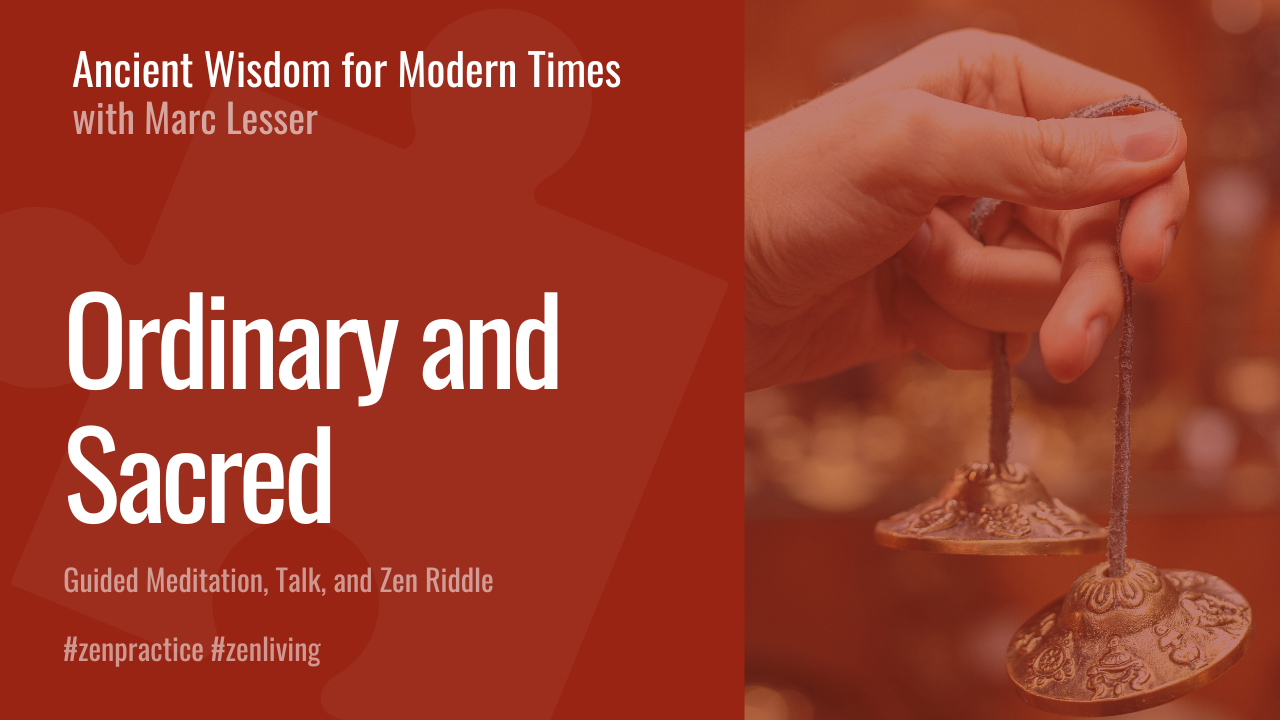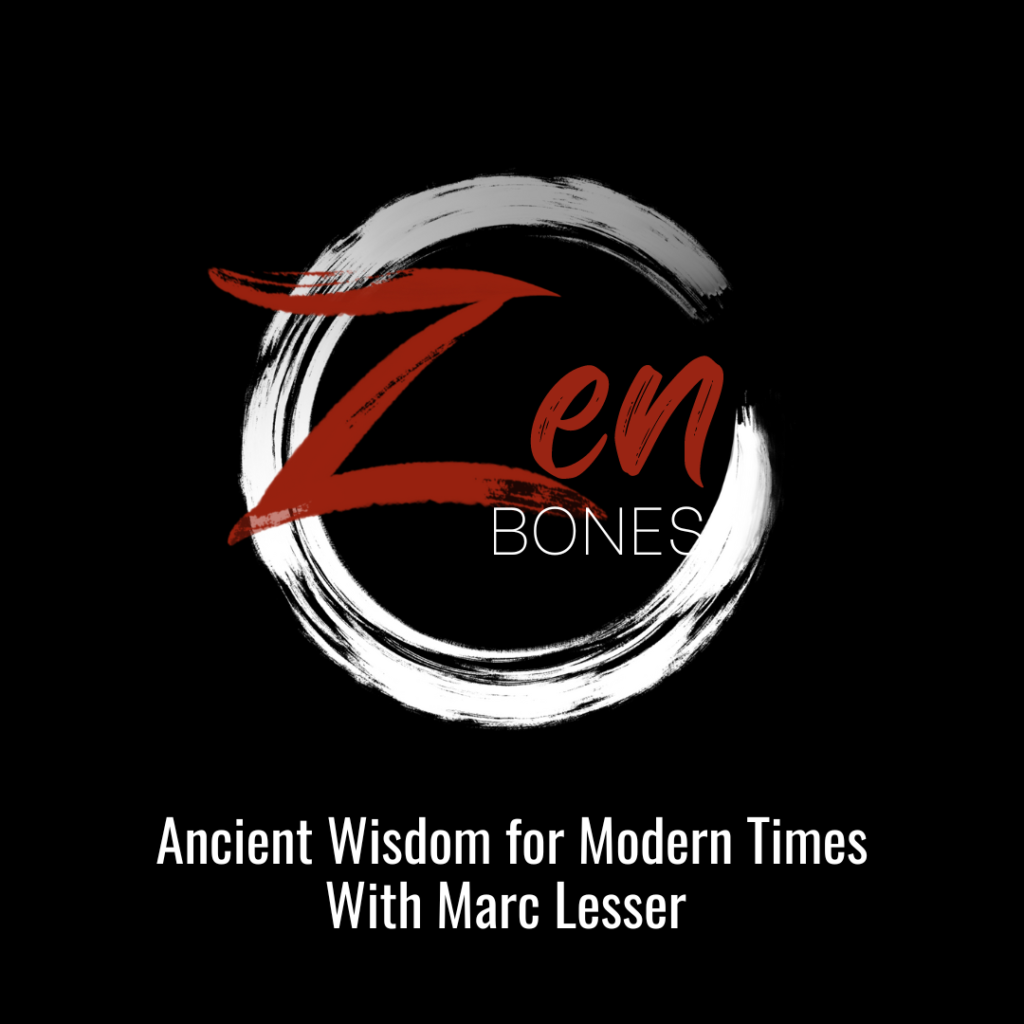We are all ordinary human beings living in an ordinary world. And yet, we are also sacred, extraordinary beings, living in an extraordinary, sacred world. Zen teacher Shunryu Suzuki says that we usually only see one side and ignore what is sacred and mysterious. During this session we have a short guided meditation, followed by a talk on living in both the ordinary and sacred world.
This episode’s Zen puzzler is based on a traditional Zen koan: A buffalo goes through a window, and every part of it goes through, except for the tail. Why doesn’t the tail go through?
EPISODE TRANSCRIPT
[music]
[00:00:02] Speaker 1: Welcome to Zen Bones: Ancient Wisdom for Modern Times. This is Marc Lesser. Why Zen Bones? Our world is in crisis and ever-shifting. Now more than ever, more wisdom, clarity, and courage are essential, especially in the world of work, business, and leadership. In today’s practice episode, the topic is we are ordinary and we are sacred or we are ordinary and we are holy. We begin with a short guided meditation to experience both our ordinariness and our sacredness.
I do a short talk on the topic, emphasizing something that Zen teacher Shunryu Suzuki says where he talks about don’t be a board-carrying fellow. Here he’s suggesting, don’t leave out the sacred and holy. Take the board off of your shoulder and see from a wider perspective. Then we do the Zen puzzler, which for this episode it is about a buffalo that jumps through the window and everything goes through the window except for the tail. This is one of my favorite Zen stories. I talk about it and do a little commentary.
Again, the overarching topic is experiencing ourselves as ordinary human beings and as sacred and holy. I hope you enjoy this episode.
Let’s do some sitting practice together. Just this simple, ordinary practice of stopping, pausing, and noticing. Checking in with the body, so finding a way, however, you are sitting, bringing awareness to the body, noticing and relaxing the muscles in the face, relaxing the jaw, and any place where there might be a holding, so relaxed. Relaxed and alert.
Sitting may be a little more upright than you may have been. Lengthening the spine, opening the shoulders. Checking in with the body, checking in with the breath. This ordinary and extraordinary act of breathing that we so often don’t pay any attention to or take for granted. Noticing. Noticing, giving some attention to the body, the breath, whatever is happening with thinking, mind, whether the mind is calm or not so calm, noticing, and gently letting thoughts come, letting them go, and if possible, bringing attention back to the breath, to the body.
That’s something, I think, both potent, miraculous, and useful of being completely here with your experience, with your sensory experience, noticing what you’re seeing, what you’re hearing, what you’re feeling, what you’re thinking, and at the same time recognizing how extraordinary it is to be alive, how extraordinary it is to be here right now, dropping into both. I think it’s using one’s imagination and embodied sense of living and feeling this extraordinary sense of being here alive, having life, having consciousness, being in relationship with all of life.
Can you feel it? Can you feel it? Can you drop into this sense of the ordinary and the holy or the extraordinary right now, right here? Whatever you might be doing, can you feel it? This breath has never happened before and won’t ever repeat again. It is distinct, it is unique. This moment is completely ordinary and holy and extraordinary. It’s not something we need to pretend. It’s more like we’ve been conditioned to only see the ordinary side of things.
It’s recognizing that and stepping in, stepping into seeing with clearer, fuller eyes and at the same time, keeping it simple, breathing in, breathing out. Then, whenever you’re ready, coming back and bringing your attention to doing whatever you are. The activity of the day, but bringing this sensibility of ordinary and only ordinary and extraordinary into each movement, into each conversation, into your work, into your relationships.
I think this is such a core part of the practice of Zen Bones, the practice of being human. I hope it goes well bringing the ordinary and extraordinary into each moment, each activity.
[music]
We are ordinary and we are holy at the same time. Sometimes I find it challenging to go about my ordinary days, my ordinary routines, my ordinary life, while I’m seeing images of despair and death and destruction in Ukraine and in other places around the world. I want to not turn away. At the same time, I don’t want to be consumed or hardened by the events of the world. I wonder how not to turn away, how to find some hope, some optimism, and at the same time, a sense of meaning and depth.
In one of my favorite books, Not Always So, which is a collection of talks by Zen teacher Shunryu Suzuki, he mentions that there is a Japanese expression, a tambankan, and it’s a person who carries a board on his shoulder. This is someone who understands things from a limited perspective, a person who holds tightly to a particular view. I think he’s suggesting that we are all such people when we think that we are only ordinary humans. When we remove this board from our shoulder, we can see and feel and experience that we are also holy, sacred, connected to the cosmos with vast abilities including the ability to shape our reality.
You may think that you are an ordinary human being with ordinary work and ordinary problems and possibilities living an ordinary life, and this is true. We are all ordinary. We are all born. We love and we work and we struggle. We get up, we fall down, and we will die. More difficult to understand and experience is that you are anything but ordinary. You are not merely you.
You are the result of many events, including from more than 13 billion years ago known as the Big Bang, followed by a most mysterious coalescing of matter and energy here on this tiny planet called Earth. In the midst of billions of stars and planets, we humans are the result of molecules forming complex structures. It’s estimated almost 4 billion years ago.
We don’t always experience it or believe it but we are a most remarkable work in progress. Shunryu Suzuki goes on to say that during meditation practice, you are both independent from everything and related to everything, both at the same time. He says, you are not just you. You are the whole world and the whole cosmos. When you sit, you are not the same being as you were before you sit.
As ordinary human beings, we plan and assess and measure. We love, we hate, we succeed and fail. We can feel confused, we can lie, we can hurt each other, even betray others. Within our organizations and beyond, we are accountable for our actions and we can hold others accountable for their actions. This is an essential part of living together, of working together, creating, innovating, and solving problems together. As sacred holy beings, we have the profound ability to literally feel the feelings of others. A friend of mine was walking toward me the other day, and her foot missed the curb, and she stumbled. My body ached from the pain of her stumble.
We have the potential to feel, to understand and to misunderstand, to help each other or to destroy each other, or we can be caring and curious. We can see from others’ perspectives, we can help comfort and heal each other. I think that experiencing ourselves as ordinary and holy is a profound important way to not get caught or consumed by the events of the world, a way to help and support us to not turn away from the world.
It’s a way of letting our hearts connect and break open, a way to help us remain present, alive, and cautiously optimistic right in the midst of the pain and difficulty and possibilities of our lives. Here’s a short poem that I like that cuts through this duality, I think, of ordinary and holy. It’s a poem by Lynn Ungar called The Way It Is.
One morning you might wake up
to realize that the knot in your stomach
had loosened itself and slipped away,
and that the pit of unfulfilled longing in your heart
had gradually, and without your really noticing,
been filled in, patched like a pothole, not quite
the same as it was, but good enough.
In that moment, it might occur to you
that your life, though not the way
you planned it, and maybe not even entirely
the way you wanted it, is nonetheless
persistently, abundantly, miraculously
exactly the way it is.
May you bring this sense of ordinary and holiness into every part of your life. Thank you.
[music]
Welcome to the Zen Bones puzzler, where I will regularly be presenting a story or a Zen koan or a poem, something to contemplate, to think about, a story that has purpose. It’s about developing greater insight and reflection, not so much for a solution, but as a way to support your practice, a meditation in daily life. Today’s Zen Bones puzzler is one of my favorite traditional Zen stories, traditional Zen koans. It goes like this. A buffalo jumps through a window and the head and shoulders and body, arms and legs all go through the window, but the tail doesn’t go through the window. Why?
I think this is a great image and one that I recommend you maybe what do you think? Buffalo jumps through the window and all the different parts of it go through, but not the tail. Why? This is a Zen story, a Zen puzzler that has been around since the fifth or sixth century China and has been passed down over these many years as worthy of questioning. There’s no right answer to these koans. I certainly don’t want to say that there is an answer but my thoughts on this– this puzzler actually reminds me a little bit of being at the birth of my children. To see that watching the amazing birth of a human being coming out of a woman’s body. I’ve been at the birth of both of my children and also watching my daughter give birth to her son. It’s a lot like this koan. The head, the shoulder, the body, everything there is this human being but there’s some connection with some other world that you can feel in a birth.
Some sense of the miracle, the mystery, the complete lack of explainability of this being. Where did this being come from? Some connection. I have a similar image of when I reflect on this puzzler, this story of being around death. Particularly I thinking of holding my mother’s hand and breathing breath by breath as my mother was dying here in my home, literally on my living room couch. That experience of that last breath and yet there she is. There’s my mother’s body, there’s whoever we might be with. Something about the way that we look at birth, and life and death and some connection with many worlds that are beyond the ordinary, beyond our experience. That’s what comes up for me in this puzzler. Maybe in more simple way too, it’s that the world is not what it seems. I once spent a week in a sesshin, a retreat in which the theme was that inanimate objects are our teachers. We were studying some of the teachings of Zen teacher Dōgen. It was a wonderful week of study, but a lot of it was very difficult and very intellectual.
At the very end of this retreat, I asked the teacher, I said, “What am I going to tell an ordinary person? What do I tell my brother who’s a electrical engineer, how did we spend this week studying? What we can learn from rocks and pebbles and bamboo, the inanimate objects preaching the dharma, inanimate objects being our teachers?” Without hesitating the teacher said, “Just tell your brother that the world is not what it seems. The world is not what it seems.” Something potent about that understanding and bringing that understanding into our daily lives. The buffalo goes through the window, the head, the shoulders, the body, arms, legs, tail, everything goes through except the tail. The tail does not go through. Why is that? You might see what you come up with for your response to this Zen puzzler. Thank you.
[music]
Listen in each week for interviews, teachings, and guided meditations, you’ll receive supportive tools for creating more meaningful work and mindfulness practices to develop yourself, to influence your organization, and to help change the world. Thank you for listening.
[00:23:01] [END OF AUDIO]









